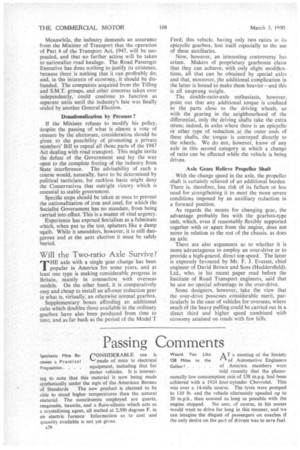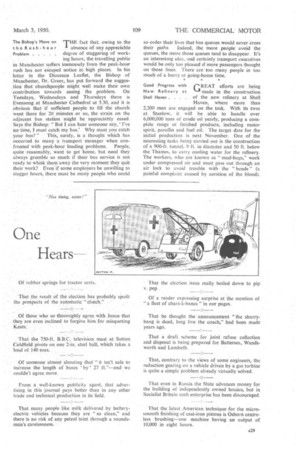Passing Comments
Page 30

Page 31

If you've noticed an error in this article please click here to report it so we can fix it.
Synthetic Mica BeCONSIDERABLE use is
comes a Practical ‘-'made of mica in electrical Proposition. . . equipment, including that for
motor vehicles. It is interesting to note that this material is now being made synthetically under the mgis of the American Bureau
of Standards The new product is claimed to be able to stand higher temperatures than the natural material The constituents employed are quartz, magnesite, bauxite, and a fluro-silicate which acts as a crystallizing agent, all melted at 2,500 degrees F. in an electric furnace Information as to cost and quantity available is not yet given. Would You Like AT a meeting of the Society 158 Miles to the " of Automotive Engineers
Gallon ? of America members were told recently that the phenomenally low consumption rate of 158 m.p.g. had been achieved with a 1924 four-cylinder Chevrolet. This was over a 14-mile course. The tyres were pumped to 110 lb. and the vehicle alternately speeded up to 20 m.p.h., then coasted as long as possible with the engine, stopped. No one, of course, in his senses would want to drive for long in this manner, and we can imagine the disgust of passengers on coaches if the only desire on the part of drivers was to save fuel.
The Bishop's Move on THE fact that. owing to the the Rush-hour I absence of any appreciable Problem degree of staggering of work ing hours, the travelling public in Manchester suffers immensely, from the peak-hour rush has not escaped notice in high places. In his letter in Me Diocesan Leaflet, the Bishop of Manchester, Dr. Greer, has put forward the suggestion that churehpeople might well make their own contribution towards easing the problem. On Tuesdays, Wednesdays and Thursdays there is Evensong at Manchester Cathedral at 5.30, and it is obvious that if sufficient people to fill the church went there for 20 minutes or so, the strain on the adjacent bus station might be appreciably eased. Says the Bishop: " But I can hear someone say, I've no time, I must catch my bus.' Why must you catch
your bus?" This, surely, is a thought which has occurred to many a hansport manager when confronted with peak-hour loading problems. People, quite reasonably, want to get home, but need they always grumble so much if their bus service is not ready to whisk them away the very moment they quit their work? Even if some employers be unwilling to • stagger hours, there must be many people who could so order their lives that bus queues would never cross their paths Indeed, the more people avoid • the queues, the more those queues tend to disappear. It's an interesting idea, and certainly transport executives would be only too pleased if more passengers • thought on those lines. There are too many people in too much of. a hurry at going-home time,.
Good Progress with r_REAT efforts are .being New Refinery at ‘'•-i made in the construction
Shell Haven . . . of the new refinery at Shell
Haven, where more than 2,200 men are engaged on the task. With its twin at Stanlow, it will be -able to handle over 6,000,000 tons of crude oil yearly, producing a complete range of finished products, including motor spirit, paraffin and fuel oil. The target date for the initial production is next November. One of the interesting tasks being carried out is the construction of a 900-ft. tunnel, 9 ft. in diameter and 50 ft. below the Thames, to carry cooling water for the refinery. The workers, who are known as "mud-hogs," work under compressed air and must pass out through an air lock to avoid trouble with the " bends " (a painful complaint caused by aeration of the blood).
































































































